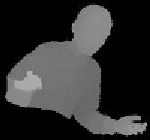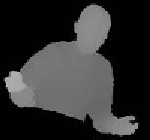Game Development Reference
In-Depth Information
Figure 9. All intermediate and final results from the view reconstruction are
listed in this figure together with the disparity data.
V
V
(a) Original left view
(b) Original right view
(c) Rectified left view
(d) Rectified right view
(e) Left disparity map
(f) Right disparity map
V
V
rectiL
rectiR
(i) Reconstructed view
(g) X-interpolated view
(h) Y-extrapolated view
V
(j) Real destination view
V
V
D
X
Summary and Conclusions
Camera calibration is fundamental to many vision systems. In this chapter, we
attempt to give the “big picture,” which may possibly accelerate the application
of camera calibration. Based on the pinhole principle, the imaging process of the
camera is modeled in the first section. All camera parameters are introduced and
their physical meaning is explained. For camera-based vision applications, all of
these parameters should be revealed implicitly or explicitly off-line in advance of
the application or on-line dynamically. Camera calibration techniques for this
purpose are classified from several different points of view in the second section.
Due to the importance of the non-linear distortion, this issue is specifically
investigated in the third section. After this, passive camera calibration tech-
niques are discussed and grouped into several categories of increasing complex-
ity in the fourth section. Each of them has specific target applications and can
provide highly accurate calibration results. Sometimes, however, accuracy is not











Search WWH ::

Custom Search